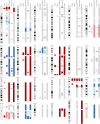Diagnostic challenges in complicated case of glioblastoma
- PMID: 39534304
- PMCID: PMC11554483
- DOI: 10.3389/pore.2024.1611875
Diagnostic challenges in complicated case of glioblastoma
Abstract
Glioblastoma is the commonest primary malignant brain tumor, with a very poor prognosis and short overall survival. It is characterized by its high intra- and intertumoral heterogeneity, in terms of both the level of single-nucleotide variants, copy number alterations, and aneuploidy. Therefore, routine diagnosis can be challenging in some cases. We present a complicated case of glioblastoma, which was characterized with five cytogenomic methods: interphase fluorescence in situ hybridization, multiplex ligation-dependent probe amplification, comparative genomic hybridization array and single-nucleotide polymorphism, targeted gene panel, and whole-genome sequencing. These cytogenomic methods revealed classical findings associated with glioblastoma, such as a lack of IDH and TERT mutations, gain of chromosome 7, and loss of chromosome 10. At least three pathological clones were identified, including one with whole-genome duplication, and one with loss of 1p and suspected loss of 19q. Deletion and mutation of the TP53 gene were detected with numerous breakends on 17p and 20q. Based on these findings, we recommend a combined approach to the diagnosis of glioblastoma involving the detection of copy number alterations, mutations, and aneuploidy. The choice of the best combination of methods is based on cost, time required, staff expertise, and laboratory equipment. This integrated strategy could contribute directly to tangible improvements in the diagnosis, prognosis, and prediction of the therapeutic responses of patients with brain tumors.
Keywords: I-FISH; MLPA; WGS; aCGH/SNP; cytogenomics; diagnostics; gene panel.
Copyright © 2024 Aghova, Lhotska, Lizcova, Svobodova, Hodanova, Janeckova, Vucinic, Gregor, Konecna, Kramar, Soukup, Netuka and Zemanova.
Conflict of interest statement
The authors declare that the research was conducted in the absence of any commercial or financial relationships that could be construed as a potential conflict of interest.
Figures

Similar articles
-
Comparison of 1p and 19q status of glioblastoma by whole exome sequencing, array-comparative genomic hybridization, and fluorescence in situ hybridization.Med Oncol. 2018 Mar 29;35(5):60. doi: 10.1007/s12032-018-1119-2. Med Oncol. 2018. PMID: 29600313
-
Clinical implementation of integrated whole-genome copy number and mutation profiling for glioblastoma.Neuro Oncol. 2015 Oct;17(10):1344-55. doi: 10.1093/neuonc/nov015. Epub 2015 Mar 9. Neuro Oncol. 2015. PMID: 25754088 Free PMC article.
-
Next-Generation Sequencing Panel for 1p/19q Codeletion and IDH1-IDH2 Mutational Analysis Uncovers Mistaken Overdiagnoses of 1p/19q Codeletion by FISH.J Mol Diagn. 2021 Sep;23(9):1185-1194. doi: 10.1016/j.jmoldx.2021.06.004. Epub 2021 Jun 26. J Mol Diagn. 2021. PMID: 34186176
-
Molecular pathologic diagnosis of epidermal growth factor receptor.Neuro Oncol. 2014 Oct;16 Suppl 8(Suppl 8):viii1-6. doi: 10.1093/neuonc/nou294. Neuro Oncol. 2014. PMID: 25342599 Free PMC article. Review.
-
Establishing a Robust Molecular Taxonomy for Diffuse Gliomas of Adulthood.Surg Pathol Clin. 2016 Sep;9(3):379-90. doi: 10.1016/j.path.2016.04.005. Surg Pathol Clin. 2016. PMID: 27523967 Review.
References
-
- Rasras S, Zibara K, Vosughi T, Zayeri Z. Genetics and epigenetics of glioblastoma: therapeutic challenges. Clin Cancer Invest J (2018) 7:43–9. 10.4103/ccij.ccij_82_17 - DOI
Publication types
MeSH terms
Substances
LinkOut - more resources
Full Text Sources
Medical
Research Materials
Miscellaneous

